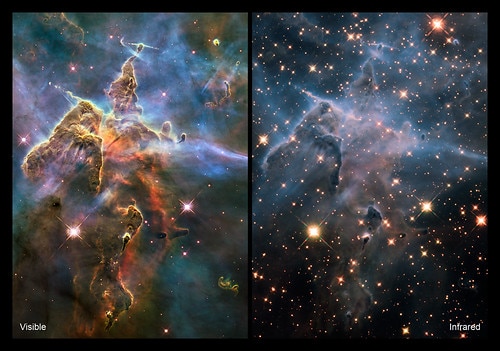EXPLAINED: How Is NASA’s Revolutionary Webb Space Telescope Different From Hubble?
Webb is a scientific successor to Hubble, because its science goals are motivated by the results from Hubble. Webb will look to longer wavelengths to “go beyond” what Hubble has already achieved.

New Delhi: The James Webb Space Telescope (JWST), the most powerful telescope ever built, launched into space on Christmas, after decades of wait.
JWST, also called Webb, began its voyage to the birth of the universe, after lifting off into space from French Guiana, South America.
The $10 billion telescope, in development since 1996, is an infrared observatory, and is the first of its kind. Webb, it is believed, will usher in a new era of astronomy and unravel the secrets of the universe.
Webb is often called the replacement of the Hubble Space Telescope, which was launched into low-Earth orbit in 1990, and has been sending breathtaking pictures of the cosmos ever since. However, NASA prefers to call Webb a “successor” to Hubble, the space agency said on its website.
JWST will look to longer wavelengths to “go beyond” what Hubble has already achieved.
ALSO READ: James Webb Space Telescope: NASA's Most Powerful Telescope Ever Launches Into Space
Webb Vs Hubble
Webb is a scientific successor to Hubble, because its science goals are motivated by the results from Hubble. An infrared telescope is needed to observe distant galaxies such as the first galaxies formed in the universe. This is because more distant objects are more highly redshifted, and their light is pushed from the ultraviolet and visible regions of the electromagnetic spectrum to near-infrared. In other words, the observed wavelength is greater than the actual wavelength of radiation emitted by the cosmic object. Since the capabilities of Webb and Hubble are not identical, the most powerful telescope in the world cannot be called a replacement for Hubble.
Webb’s primary goals are to look at the universe at infrared wavelengths, while Hubble primarily studies the cosmos at optical and ultraviolet wavelengths. Also, Webb has a much bigger mirror than Hubble. Since Webb has a much larger light collecting area, it can peer further back in time than Hubble is capable of doing.

Also, Hubble orbits the Earth at a close distance, while Webb will orbit the Sun, 1.5 million kilometres away from our planet, at the second Lagrange point (L2).
Size Comparison Between Webb & Hubble
The primary mirror of Webb has a diameter of approximately 6.5 metres, while Hubble has a smaller mirror, 2.4 metres in diameter. Since Webb has a larger mirror, this would give the telescope a significantly larger collecting area than the mirrors of other space telescopes.
Hubble’s mirror has a light collecting area of 4.5 metre square, while Webb’s collecting area is around 6.25 times more. Webb’s primary mirror has 18 hexagonal mirror segments measuring 4.3 feet or 1.32 m in diameter. It also has a small secondary mirror that measures 2.4 feet or 0.74 m across.
Webb will have a significantly larger field of view than the Near Infrared Camera and Multi-Object Spectrometer (NICMOS) instrument on Hubble, and will cover more than 15 times the area.
The dimensions of Webb’s sunshield are 22 metres by 12 metres. The sunshield is about half as big as a 737 aircraft, and is about the size of a tennis court.
Webb’s Orbit Vs Hubble’s Orbit
The Hubble Space Telescope orbits the Earth at an altitude of around 570 kilometres above the planet, according to NASA. Webb will not orbit Earth, but will orbit the Sun, and will sit at the Earth-Sun L2 Lagrange point, 1.5 million kilometres away, NASA said.
It was possible to launch Hubble using the space shuttle rocket because the telescope had to be sent to Earth orbit. However, Webb was launched on an Ariane 5 rocket because it will not be in Earth orbit, and is not designed to be serviced by the space shuttle.
Webb will orbit the Sun with Earth, but will stay fixed in the same point with relation to the Earth and Sun. Unlike Webb, other satellites orbit around the L2 point, and do not remain completely motionless at a fixed spot.
Since Webb will operate much farther from Earth, the telescope will maintain an extremely cold operating temperature, and will have a hugher observing efficiency than with the Earth-observing Hubble.
How Far Will Webb See Compared To Hubble?
Hubble can see the equivalent of “toddler galaxies” or young galaxies, while Webb will be able to see “baby galaxies”, or the newborn galaxies, according to NASA. Webb will be able to see the first galaxies because it is an infrared telescope. The telescope will also look back in time to observe the earliest stars.
Webb is designed to look deeper into space to look deep into nearby dust clouds to study the formation of stars and planets. It has infrared instruments with longer wavelength coverage and greatly improved sensitivity than Hubble.
Both Hubble and Webb can look back in time. Hubble has the ability to observe how the universe was 12.5 billion years ago. Webb is a powerful time machine with infrared vision that will look back in time, more than 13.5 billion years.
Related Video
Southern Rising Summit 2024: How Important is Self-Awareness? Insights from Anu Aacharya | ABP LIVE






































